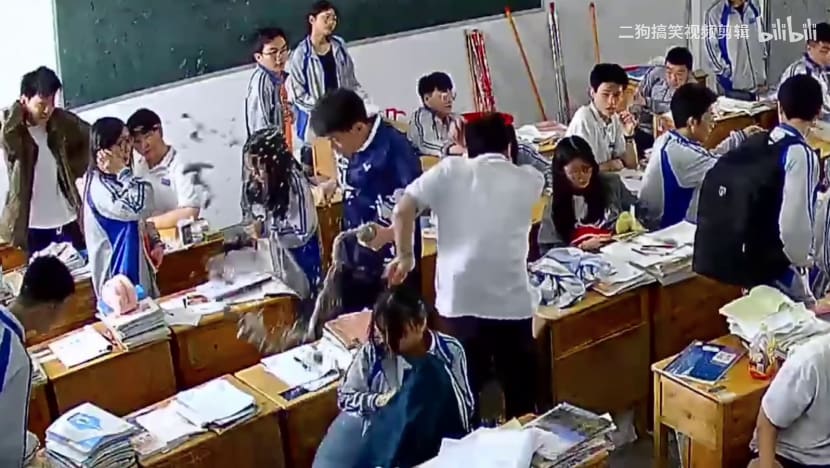‘Rearing stinky water’ becomes a fad among students in China despite safety, health risks
Adding “bugs, milk, hand lotion” and anything else they can get their hands on, students in China have been mixing bottles of “stinky water” to watch them “explode”.

Videos on popular video-sharing website Bilibili showed people adding bugs and leaves into a plastic bottle, and documenting the moment the bottle "explodes". (Images: Bilibili/是9岗呀, 一只普通的鹰酱666)

This audio is generated by an AI tool.
SINGAPORE: Snail eggs, stink bugs and leaves. A young man films himself throwing these items into a plastic bottle filled with water and sealing it.
“Day 1 of rearing stinky water, gathering ingredients,” goes the title of his video, posted on popular video-sharing website Bilibili.
He documents how the contents of the bottle change. A fitting finale? If the bottle explodes.
The trend, literally translated as “rearing stinky water”, has caught on among primary and secondary school students in China.
There is no set recipe for making “stinky water”.
According to a report by Beijing News, students would throw things such as “milk, bugs, hand lotion” and even rat tails into a plastic water bottle.
They would then observe the changes, wait for it to “explode” and share the process on social media.
There have been reports of bottles of “stinky water” exploding in classrooms, causing damage to school computers and leaving a foul odour, Beijing News reported. The stench has also reportedly led many students to throw up.
One video reposted on Bilibili showed the moment a bottle of “stinky water” exploded in a classroom.
A male student is earlier seen playing with the bottle and hitting it with keys. When the bottle explodes, it sprays filthy brown water on tables and books as his peers scream in shock.

The trend of concocting “stinky water” is apparently not new and predates the rise of social media, according to some netizens in China who shared how they did the same in their school days.
“I was born in 1996, I used to play this back in primary school. (I) grabbed a bottle from the field, whatever I saw I picked it up - sand, waste paper, ants,” commented one Bilibili user.
Once, he did not realise the bottle had holes in it. It leaked, and “my form teacher was not amused”, he recounted.
State news channel CCTV spoke to doctors, who warned that children may inadvertently create harmful substances in their mixtures.
“During the process of ‘rearing stinky water’, the mixture continues to ferment and it may produce harmful gases such as hydrogen sulphide and formaldehyde. If these gases are inhaled, they may cause poisoning, nausea and dizziness in children,” CCTV reported.
Besides harmful gases, doctors also warned of bacteria and viruses in the brew. “If children do not wash their hands properly after coming into contact with the mixture, or even eat right after playing, this may lead to digestive tract infection.”
Besides public hygiene concerns, schools and parents may also have to bear responsibility if a bottle of “stinky water” explodes in school and causes damage, CCTV reported.
Some view the fad as a show of children’s curiosity as they seek to understand things around them.
Children are making “such dirty, smelly and dangerous things” simply for fun and excitement, according to an opinion piece in Beijing News.
Discouraging adults from stifling this desire to explore, the article added: “It is the responsibility of the families, schools, even the whole of society to guide children on how to properly express this curiosity.”













